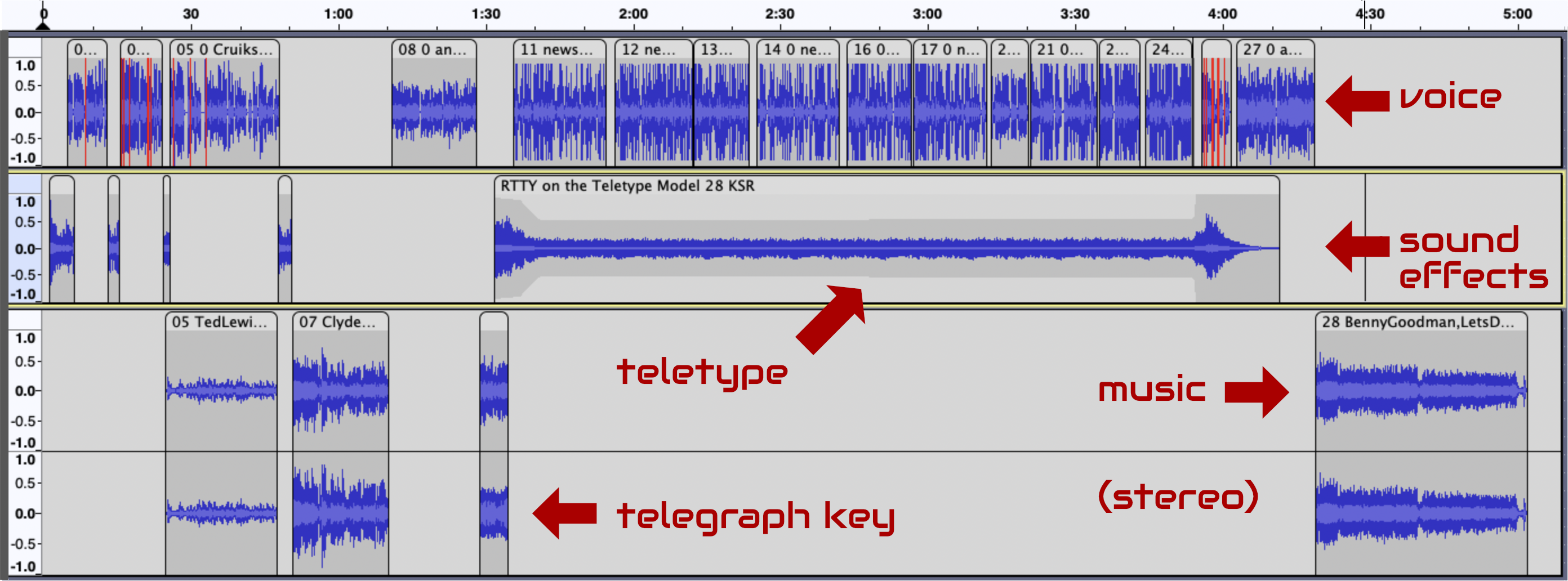 |
| Love that cover! |
Prohibition Peepers, the trailer how-to continues from last week. Visual presentation typically drives videos, but as described last week, ours is centered around a soundtrack of a 1932 radio news broadcast. Today I'll thread two paths, a how-to for those interested simple, quick video creation and, historical notes and thoughts as I’m constructing this castle in the air.
Tools of the Trade
Any straightforward graphics apps and video creation program will do. I chose simple apps, nothing fancy.¹
Apple’s iMovie assembled pictures along with last week’s sound track, which was handed off to YouTube. Any simple video builder should work; Windows offers several options. It should be possible to create a slide show with Microsoft Power Point, but its learning curve requires more patience than I have Adderal. I opted for a dedicated video program.
It is possible to create a presentation with nothing but YouTube, but maintaining files locally felt more comfortable.
For graphics, I used both raster (bitmap) and vector images. Abandoning high-priced Adobe, I switched to Serif’s Affinity suite. It’s a clean, easy to use, inexpensive panel of picture programs. One of the best features is that Affinity files are interchangeable, meaning any Affinity program can work directly with any Affinity file. It makes life easy.²
Finally, we’ll touch upon AI.
To Err is Human
Abruptly, I made my first mistake. In the past, I’d loaded a few items to YouTube, mainly a collection of Rocky King TV shows. Visual recordings of the era weren’t locked into any one size. Historically, aspect ratios have appeared as 1:1, 3:2, 4:3, and 16:9, but others proliferated.
I erred immediately. I had decided upon YouTube’s original default 3:2 as a compromise between stretching, cropping, and ‘letterboxing’, awkward ways of dealing with aspect ratios outside the norm. After creating an initial half dozen or so 1800×1200 images, I opened iMovie… and could not find the menu item for aspect items. Annoyed, I opened YouTube’s editor… and once again could not find the menu for screen rations. They were gone. Vanished. Disappeared. Demised.
WTF? (Lithuanian for Huh?) I googled and googled and finally learned in recent versions, YouTube and iMovie have settled upon a common aspect ratio, 16:9. Damn. Never guessing both Apple and Google had finally standardized, I’d wasted valuable time and effort. Let my error guide you.
Fortunately, the waste wasn’t as bad as first thought. Many of my source images were 1800 pixels high. I settled upon 3200×1800 as my working size in the Affinity programs. A multiple of 100 and a power of two facilitates quick, mental calculations. YouTube’s HD maximum is 1920×1080, so I was over-engineering.³
Action
I had numbered each paragraph of the script and appended that same number to graphics I intended to use. iMovie permitted me to load all at once and optionally space them n seconds apart. The final result would not be evenly spaced, but 5 minutes ÷ 28 slides allowed me to spread them across the timeline, meaning each was somewhat proximate to its intended position.
- The first slide recognized the significance of border radio, chiefly remembered in songs by the Doors, Z Z Top and others, and at least one movie, O Brother, Where Art Thou.
- Next we hear a sly evangelist trawling for donations. I had a little fun with the picture, an interrupted letter suggesting a small story in itself. Earlier in 1932, the post office had raised first class rates from 2¢ to 3¢. On the theory people like my mother might still have 2¢ stamps, I pasted a 1932 2¢ and 1¢ on the envelope.
- Likewise, the $2 bill series date was consistent with 1932, but a sharp detective might notice oddities. The handwriting is feminine but looks a bit young or naïve. The Reverend asks for a dollar donation, but Prunella intends to send two dollars (value of $45 today) plus a letter. He suggests a plain white envelope, but our charming correspondent selects pink lavender stationery… you can almost catch a scent of perfumed powder in it. What might happen when the Rev read the letter?
- Unregulated patent medicines were loaded with alcohol and opiates. Little wonder laudanum became the preferred energy drink, the feel-good medication sold by the doctor’s breathy assistant. Dr Cruikshank looks awfully familiar.
- When I was a child, ‘Tear It Down’ and other Clyde McCoy pieces appealed to me. His lip control and wah-wah mute could almost make a jazz trumpet talk. The hotel interior pictured is the real McCoy… the actual Congress Hotel ballroom.
- A teletype introduces the news with a silent movie news placard bearing ‘A Mixed Metaphor Production’, suggesting the irony of radio visual aids hasn’t been lost.
- The news opening referring to the incoming president and that Congress just approved 3.2% beer is factual. The next part about Ness, Moran, and Capone appears in support of the events in my story ‘Dime Detective’. Likewise the next paragraph refers to John Floyd’s story, ‘River Road’, and the awesome Windsor Manor without giving away the plot.
- Celebrity news comes next, homicides involving a dancer and an actress (‘Getting Away Clean’ by Joseph Walker and ‘Bearcat Blues’ by Susanna Calkins). Here we make an unusual departure. Neither pictured performer is real. Each is AI computer generated using ChatGPT teamed with Dall-E. I experienced a LOT of difficulty rendering the images. The programs has great difficulty with rendering eyes and counting fingers and arms.
- An ad for Penny Mickelbury’s Bubba’s Gym in ‘The Devil You Know’ provides a transition to sports. The Chicago Bears playoff is factual, but of course Steve Liskow’s story, ‘Peace of Mind Guaranteed’, is fanciful.
- Hugh Lessig returns us to a fictional page of mystery history in ‘Cloths of Heaven’, a sad tale of the first woman Prohibition casualty. Amazingly, I found a photo of an actual rum-runners boat seized in Virginia.
- I slipped in a slide of a simple (and operational) crystal radio schematic where my real voice can be heard.
- The wrap-up reflects the beginning. The outro pictures the actual Blackstone Hotel featuring homeboy Benny Goodman who, in 1932, hasn’t yet made a national splash. He plays as credits roll, wrapping up with the message that Prohibition Peepers can be found in fine speakeasies and bookstores everywhere.
| © 2023 Prohibition Peepers |
||
Done! I saved the file as an .mp4, ready to upload to SleuthSayers’ channel.
This article grew longer than I like, so next week I’ll explain how to add closed captioning.
Tables








































